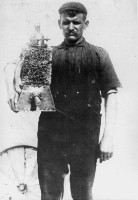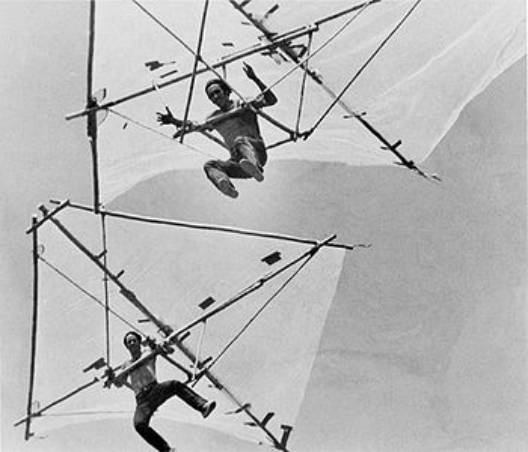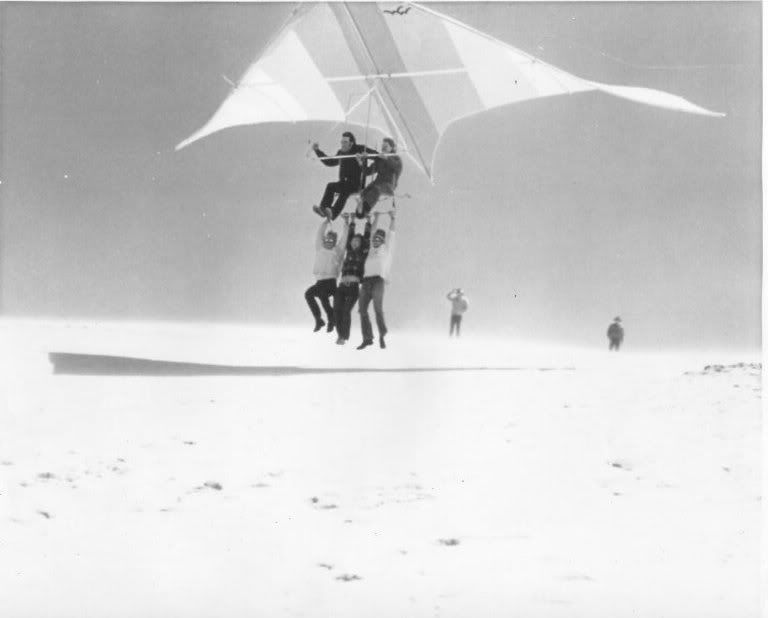HG's "kite" strings' history notes
Posted: 2013/03/14 00:41:22 UTC
This topic addresses the "kite" strings of kite hang gliders and its history.
A kite may be seen as consisting of three parts: wing set, tether set between wingset and resistive part, and the resistive part.
A kite hang glider is a kite system with its wing set, tether set between wing and resistive part (set of hang lines), and the resistive part (the pilot and harness and items held by pilot and harness... all of which are payload drawn down by gravity to provide the function of the resistive part of the kite hang glider system). The kite hang glider may have a wing set of one or more wings. The kite hang glider may have one or more kite strings in its tether set. The kite hang glider's resistive set may consist of one or more masses. A kite hang glider may be habited or uninhabited (manned, womaned, or not; that is, a non-human payload may provide the resistive function in a kite hang glider). A very common kite hang glider is the sort that has one wing, a simple tether hang-line set, and a harnessed pilot as resistive part. A very simple habited hang glider of wing of left and right parts with some battens and a simple hung pilot behind a cable-stayed A-frame was demonstrated in a 1908 gliding-club's flight meet in Breslau; such was evidence enough that such system could not be later mechanically "invented" as texted erroneously by many orgs today.
Note added: The resistive set of a free-flight kite hang glider can also be seen as a wing with its L/D; e.g., a harnessed pilot in a kite hang glider deflects the apparent wind as a wing.
Invited are notes about the "kite" string in kite hang gliders from way back to the present. Welcome is the view of seeing "kite strings" as a set of one or more lines.
This topic is not about the "kite" string of systems that are not gliding yet; that is, not about the tow lines that launch some wings into gliding modes; such tow lines are kite lines, but of a non-gliding arrangement; tow lines are a hot topic in other threads of this forum. To stay on topic, consider facing just the tether set of kite hang gliders (gliding mode). The kite hang gliders are gliding kite systems as the three parts are effectively doing their job whilst the resistive part is freely falling ... i.e., a free-flight gliding kite system whose anchor is in free air.
Hopefully we may bring forward the kite strings of some early swing seats of Chanute and others. When do we see kite hang glider strings that are straps? One strap? Two straps? When we we first see three or more lines in a tether set of a kite hang glider? High-count-membered tether sets in the kite string set of kite hang gliders? Maybe an array of stings in a net arrangement? Stiffened strings for the tether set? The terminals of the elements of the tether set? Terminals at the wing? Terminals at the harness or seat? Materials? Testing? Inspections? Damage recognition? Log of use?Sources of damage? Age? UV damage? Storage damage? Incidents regarding the kite strings of kite hang gliders? Etc.
Over time, have fun on this. Yet explore lessons and what might be learned for the future. Consider how the history might bring on some future about the kite strings for kite hang gliders? Disconnects, elasticity, streamlining, double-duty, etc.? Integrity of the members of the tether set? Self-recording and self-status-reporting kite strings of kite hang gliders?
Ask questions that others might explore. How might the tether set play in injuries? Connecting the tether set challenges? Log of the tension in a tether set during the full course of flight? How to record such history? Colors? Sounds? Cushioning? How might the tether set be involved in various Safe-Splat arrangements?
No rush. Visit this thread from time to time and further the matter as you like.
Joe
A kite may be seen as consisting of three parts: wing set, tether set between wingset and resistive part, and the resistive part.
A kite hang glider is a kite system with its wing set, tether set between wing and resistive part (set of hang lines), and the resistive part (the pilot and harness and items held by pilot and harness... all of which are payload drawn down by gravity to provide the function of the resistive part of the kite hang glider system). The kite hang glider may have a wing set of one or more wings. The kite hang glider may have one or more kite strings in its tether set. The kite hang glider's resistive set may consist of one or more masses. A kite hang glider may be habited or uninhabited (manned, womaned, or not; that is, a non-human payload may provide the resistive function in a kite hang glider). A very common kite hang glider is the sort that has one wing, a simple tether hang-line set, and a harnessed pilot as resistive part. A very simple habited hang glider of wing of left and right parts with some battens and a simple hung pilot behind a cable-stayed A-frame was demonstrated in a 1908 gliding-club's flight meet in Breslau; such was evidence enough that such system could not be later mechanically "invented" as texted erroneously by many orgs today.
Note added: The resistive set of a free-flight kite hang glider can also be seen as a wing with its L/D; e.g., a harnessed pilot in a kite hang glider deflects the apparent wind as a wing.
Invited are notes about the "kite" string in kite hang gliders from way back to the present. Welcome is the view of seeing "kite strings" as a set of one or more lines.
This topic is not about the "kite" string of systems that are not gliding yet; that is, not about the tow lines that launch some wings into gliding modes; such tow lines are kite lines, but of a non-gliding arrangement; tow lines are a hot topic in other threads of this forum. To stay on topic, consider facing just the tether set of kite hang gliders (gliding mode). The kite hang gliders are gliding kite systems as the three parts are effectively doing their job whilst the resistive part is freely falling ... i.e., a free-flight gliding kite system whose anchor is in free air.
Hopefully we may bring forward the kite strings of some early swing seats of Chanute and others. When do we see kite hang glider strings that are straps? One strap? Two straps? When we we first see three or more lines in a tether set of a kite hang glider? High-count-membered tether sets in the kite string set of kite hang gliders? Maybe an array of stings in a net arrangement? Stiffened strings for the tether set? The terminals of the elements of the tether set? Terminals at the wing? Terminals at the harness or seat? Materials? Testing? Inspections? Damage recognition? Log of use?Sources of damage? Age? UV damage? Storage damage? Incidents regarding the kite strings of kite hang gliders? Etc.
Over time, have fun on this. Yet explore lessons and what might be learned for the future. Consider how the history might bring on some future about the kite strings for kite hang gliders? Disconnects, elasticity, streamlining, double-duty, etc.? Integrity of the members of the tether set? Self-recording and self-status-reporting kite strings of kite hang gliders?
Ask questions that others might explore. How might the tether set play in injuries? Connecting the tether set challenges? Log of the tension in a tether set during the full course of flight? How to record such history? Colors? Sounds? Cushioning? How might the tether set be involved in various Safe-Splat arrangements?
No rush. Visit this thread from time to time and further the matter as you like.
Joe




